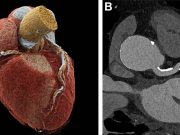Tag: Stents
P2Y12 Inhibitor Monotherapy Beneficial for Patients Who Undergo PCI
Risk for major adverse cardiac and cerebrovascular events lower compared with aspirin monotherapy for patients who undergo PCI and discontinue DAPT
De-Escalating DAPT to Ticagrelor Monotherapy Cuts Bleeding Risk in Acute Coronary Syndrome
Lower risk for bleeding without increase in ischemic events seen for patients with acute coronary syndrome
Radial Access for Percutaneous Coronary Intervention Now Dominant Method
Radial access tied to lower mortality, bleeding, and vascular complications
In-Hospital Mortality Rare After Percutaneous Coronary Intervention
Circumstance of death most often related to prior acute cardiovascular condition
Paclitaxel-Coated Balloon Effective for Coronary In-Stent Restenosis
Paclitaxel-coated balloon superior to uncoated balloon for composite end point of target lesion failure
Intravascular Imaging Guidance of PCI Reduces Death, Heart Attack
Compared with angiography guidance, intravascular imaging-guidance enhanced safety, effectiveness of PCI
Ultrahigh-Resolution CCTA Has High Diagnostic Accuracy for Coronary Artery Disease
In a recent study, AUC of ultrahigh-resolution photon-counting coronary CT angiography was 0.93 per participant for detection of coronary artery disease
Five-Year Composite Outcome Similar for TiNO-Coated Stent, Everolimus-Eluting Stents
In patients with acute coronary syndrome, decrease seen in cardiac death, MI, stent thrombosis with TiNO-coated stent, which was offset by increase in target lesion revascularization
Long-Term Outcomes Similar for Bioresorbable Vascular Scaffolds Versus Metal Stents
Increased events seen through three-year follow-up, but similar event rates observed between three and five years
Outcomes Superior With CABG Versus Multivessel PCI
CABG linked to lower hospital mortality, fewer hospital admissions at three years, less repeat PCI, improved three-year survival














